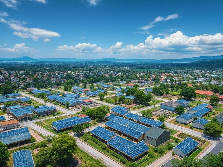
H1: State Significant Development: The Engine Driving Australia’s Major Projects Forward
\Remember that massive new renewable energy hub proposed near your town? Or the game-changing hospital upgrade finally getting off the ground in the city? Chances are, they’re not slogging through your local council’s standard development application queue. They’re likely on the State Significant Development (SSD) fast track. As someone who’s spent over seven years dissecting planning systems and helping projects navigate them (including plenty of SSDs), let me tell you, understanding SSD isn’t just for policy wonks anymore. It’s crucial for developers eyeing big opportunities, communities wanting a real say, and anyone curious about how Australia actually gets its major infrastructure and economic engines built. Forget dry legal definitions; let’s unpack what SSD really means on the ground in 2025, why it’s both celebrated and contested, and how it’s shaping our future landscapes.
Cutting Through the Noise: What Exactly Is State significant development?
Simply put, State Significant Development (SSD) is a special planning pathway reserved for projects deemed so large, complex, or strategically important that their approval is handled directly by the State government, bypassing the usual local council processes. Think of it as the “express lane” for projects that have statewide implications – whether that’s boosting the economy on a massive scale, delivering critical infrastructure, managing resources, or tackling significant environmental challenges that cross local boundaries.
Why create such a pathway? Well, imagine a billion-dollar wind farm needing approvals from five different councils, each with slightly different rules and timelines. The potential for delays, inconsistencies, and outright gridlock was immense. SSDs emerged as a solution to cut through that red tape, centralise complex decision-making, and provide greater certainty (in theory, at least) for projects vital to the state’s broader goals. The thresholds triggering SSD status vary significantly between states and territories – what makes a project “significant” in resource-rich Western Australia (think major mines or LNG processing) is very different from the triggers in densely populated New South Wales (think towering CBD developments or major transport interchanges).
Crucially, SSD isn’t a free pass. It’s a different process, often with its own, potentially even more rigorous, assessment requirements, especially concerning environmental and social impacts. The key shift is who makes the final call. Instead of local councillors, the decision typically rests with the relevant State Minister (like the Minister for Planning or Resources) or an independent panel appointed by the state, guided by specialist state government departments and agencies. This centralisation aims to weigh local concerns against broader state interests more explicitly. In 2025, we’re seeing states refine these thresholds constantly. For instance, NSW recently tweaked its criteria to better capture large-scale data centres and advanced manufacturing facilities, reflecting shifting economic priorities.
Why Go SSD? The Compelling Drivers
(Image Suggestion: An infographic highlighting key benefits: Clock icon for Speed, Dollar sign for Economy, State Outline for Strategic Alignment.)
The allure of the SSD pathway for proponents (developers, government agencies, mining companies) is undeniable, primarily hinging on three big factors:
-
Speed (Relatively Speaking): Let’s be real, “fast-tracked” in planning terms rarely means fast by normal standards. However, compared to the potential quagmire of multiple council approvals, sequential referrals, and potential appeals at multiple levels, the SSD process can offer a more streamlined, predictable timeline. Decisions are consolidated into a single, state-level assessment, often with statutory timeframes the state government is incentivised to meet. For projects where time literally equals money (like mines with finite resource prices or hospitals facing urgent demand), this centralisation is a major drawcard. A 2024 Infrastructure Australia report noted SSD projects, once formally accepted into the process, often reached determination 30-50% faster than comparable complex projects assessed solely under local schemes – though the pre-lodgement phases can still be lengthy.
-
Economic Muscle & Statewide Impact: SSDs are, by definition, the heavy lifters. We’re talking projects with capital investment often in the hundreds of millions or billions, employing thousands during construction and operation, generating significant export income or tax revenue, or fundamentally transforming regional economies. Think the Snowy 2.0 hydro project, massive offshore wind farms like the Star of the South, or new mineral processing plants. The state government has a direct stake in seeing these succeed for the broader economic health of the jurisdiction. The SSD process allows the state to actively shepherd these projects, aligning them with state economic strategies and infrastructure plans in a way fragmented local approval struggles to achieve.
-
Handling Complexity and Scale: Some projects are simply too big, too technically complex, or have impacts too widespread for a single local council to manage effectively. A new container terminal impacts state freight networks, national port strategies, and potentially international shipping lanes. A major dam affects water security across entire river basins spanning multiple local government areas. The SSD framework provides the consolidated expertise (state environmental agencies, transport authorities, heritage bodies) and the jurisdictional authority to assess and manage these intricate, large-scale impacts holistically. It provides a single point of coordination for complex environmental impact statements (EIS) and comprehensive consultant teams.
The Flip Side: Navigating the Challenges and Controversies
(Image Suggestion: A balanced scale with icons representing community, environment, and government on one side, and a construction icon on the other.)
While the rationale for SSD is clear, it’s far from a universally applauded model. The very features that make it efficient for large projects can create significant friction points:
-
Community Concerns & The “Democratic Deficit”: This is arguably the biggest and most persistent criticism. When decision-making moves from the local council chamber to a state Minister’s desk in the capital city, communities directly affected often feel sidelined and disempowered. The perception (and sometimes reality) is that local voices carry less weight against powerful proponents and state economic imperatives. Phrases like “done to us, not with us” are common. While SSD processes do mandate community consultation, critics argue it often feels tokenistic – information presented after key design decisions are locked in, complex documents hard to access, and limited avenues to genuinely influence the outcome compared to traditional local DA objections and appeals. Recent reforms, like Victoria’s enhanced Community Engagement Requirements for SSDs introduced in late 2024, aim to address this, but scepticism remains high in many regions.
-
Environmental & Social Impact Scrutiny: Does centralisation lead to weaker environmental standards? Proponents argue the opposite, pointing to the rigorous EIS requirements. However, critics contend that the state, driven by economic goals, can be more susceptible to downplaying or overriding significant environmental or social impacts identified during assessment. The absence of a third-party merits appeal right (common in local DA processes) means if a community group believes impacts haven’t been adequately addressed, their only recourse is often expensive judicial review in the Land and Environment Court (or equivalent), focusing on legal process errors, not the merit of the decision itself. Balancing genuine state interest with robust environmental and heritage protection remains a constant tension.
-
Local Planning Override & Infrastructure Strain: SSD projects can sometimes feel like they land from outer space, disregarding carefully crafted local environmental plans (LEPs). A massive warehouse complex approved on land zoned for rural residential use, citing state economic benefits, creates understandable local resentment. Furthermore, these mega-projects place immense, immediate strain on local infrastructure – roads not built for thousands of construction vehicle movements, sewage systems needing urgent upgrades, schools bursting at the seams. While proponents contribute to mitigation (through Voluntary Planning Agreements – VPAs), the timing and adequacy of this infrastructure delivery is a perpetual headache for councils and residents. The question “Who pays for the real long-term costs?” is often left uncomfortably unresolved.
state significant development Journey: From Concept to Concrete (Understanding the Process)
(Image Suggestion: A simplified flowchart showing key SSD stages: Proposal > Scoping > EIS > Exhibition > Assessment > Determination.)
While details vary by state (always check your specific jurisdiction’s legislation!), the SSD lifecycle generally follows a recognizable pattern:
-
Gatekeeping: Is it SSD? The proponent typically submits a formal request or ‘gateway’ application to the state planning department (e.g., the NSW Department of Planning, Housing and Infrastructure; Victoria’s Department of Transport and Planning). The department assesses the project against the state’s specific SSD thresholds (size, investment, type, location) and strategic importance. A critical step! If deemed SSD, the project proceeds under that framework. If not, it’s usually kicked back to the local council. States are increasingly offering pre-lodgement meetings to clarify this threshold early on.
-
The Deep Dive: Environmental Impact Assessment (EIA): This is often the most resource-intensive phase. The proponent must prepare a detailed Environmental Impact Statement (EIS) – sometimes called an Environmental Effects Statement (EES) or similar. This isn’t just about trees and animals; it covers all potential impacts: noise, traffic, social, economic, visual, heritage, water, air quality, you name it. Scoping documents issued by the department outline exactly what needs to be studied. Specialist consultants are hired, years of baseline data might be collected, complex modelling undertaken. The draft EIS is then placed on public exhibition, inviting formal submissions from anyone (community, agencies, experts). In 2025, we’re seeing a big push towards more accessible EIS summaries, interactive online portals (like the NSW Planning Portal), and digital tools for submissions.
-
Exhibition, Submissions & Assessment: The draft EIS undergoes public scrutiny, typically for 28-60 days. Submissions are collated. The proponent then must respond to these submissions, often requiring revisions or additional studies, leading to a final EIS. The state planning department (or an independent panel like the Victorian Planning Advisory Committee – PAC) then undertakes a comprehensive assessment. They review all documents, submissions, proponent responses, and agency advice (health, environment, transport, heritage etc.). They weigh the project’s merits against its impacts and relevant planning policies.
-
The Decision & Beyond: Based on the assessment, a recommendation is made to the relevant State Minister (or sometimes an independent commission). The Minister makes the final decision: approval (often with a long list of strict conditions), approval with modifications, or refusal. Conditions cover everything from construction management and environmental offsets to ongoing monitoring and community liaison committees. Importantly, SSD approvals generally cannot be appealed on their merits by third parties (like neighbours or community groups) – only challenged in court on points of legal process. Compliance with conditions is then monitored by the state department.
SSD in Action: Real-World Examples Shaping 2025
(Image Suggestion: A collage of project photos: Powerhouse Ultimo construction, a wind turbine being installed, Queens Wharf Brisbane skyline.)
Theory is one thing; seeing SSD play out on the ground brings it to life. Here are a few notable Australian examples making waves:
-
Sydney’s Powerhouse Parramatta (NSW): A classic, albeit controversial, SSD. Relocating the Powerhouse Museum to Parramatta was a major state government cultural and urban renewal strategy. Approved as SSD due to its state significance in tourism, culture, and driving Western Sydney development. It navigated significant heritage debates (regarding the original Ultimo site) and complex design challenges, showcasing the state’s ability to push through large-scale civic projects. Its ongoing construction is transforming the Parramatta riverfront.
-
Golden Plains Wind Farm (Vic): Reflecting the renewable energy surge. This massive project (over 200 turbines) near Geelong was declared SSD due to its scale and contribution to Victoria’s ambitious renewable energy targets (95% by 2035). It highlights how SSD is crucial for accelerating the energy transition, dealing with complex grid connection issues and landscape impacts across broad areas. It underwent a rigorous EES process involving extensive community consultation and environmental studies. Approved in 2024, construction is ramping up significantly in 2025.
-
Queens Wharf Brisbane (Qld): A transformative integrated resort, entertainment, and residential precinct in the heart of Brisbane. Declared SSD for its projected massive economic impact (tourism, jobs, investment) and city-shaping nature. It involved complex negotiations over public space, heritage components (like the old Police Headquarters), traffic management, and design integration with the river. The SSD process managed the coordination of multiple developers and stakeholders under a single approval umbrella. It’s now a dominant feature of Brisbane’s CBD skyline.
The Evolving Landscape: SSD Trends to Watch in 2025 and Beyond
(Image Suggestion: Icons representing trends: Green Leaf for Sustainability, Gear for Technology, People Silhouettes for Community, Globe for Climate.)
The SSD system isn’t static. It’s constantly adapting to new pressures and priorities. Here’s what’s shaping it right now:
-
Sustainability & Climate Resilience Front and Centre: SSD assessments are increasingly demanding rigorous climate change adaptation and mitigation strategies. This isn’t just about a project’s emissions; it’s about how resilient its design is to future sea-level rise, extreme heat, and bushfire risk. Proponents must demonstrate water sensitivity, circular economy principles (waste reduction, reuse), and biodiversity net gain. Expect even stricter requirements on embodied carbon in construction materials as states push towards net-zero targets. Projects failing on these fronts face much tougher scrutiny, regardless of economic benefits.
-
Tech-Driven Transparency & Efficiency: States are heavily investing in digital planning platforms to make SSD processes more transparent and efficient. Think interactive project dashboards, online submission portals, virtual community information sessions, AI-assisted document analysis for assessment teams, and digital twins for visualising impacts. NSW’s Planning Portal enhancements and Victoria’s new Digital Planning System are prime examples. This aims to improve accessibility and potentially speed up parts of the process, though meaningful community engagement remains a challenge tech alone can’t solve.
-
Refining Community Engagement – Beyond the Tick Box: The backlash against perceived community exclusion is driving tangible changes. States are experimenting with earlier and more meaningful consultation models – co-design workshops, independent community advisors, dedicated community benefit funds negotiated upfront, and clearer explanations of how input influenced decisions (or why it didn’t). Victoria’s Community Engagement Charter for Significant Projects is a key initiative. The effectiveness of these reforms in genuinely rebuilding trust is a major focus for 2025/26.
-
Acceleration for “Priority” Sectors: Facing housing crises and energy transitions, states are creating super-fast-track lanes within the SSD framework for specific project types. Examples include NSW’s Critical State Significant Infrastructure (CSSI) pathway for essential energy and water projects and Victoria’s Fast-Track Program for renewable energy and select social housing projects. These involve truncated timeframes and potentially reduced exhibition periods, heightening community concerns but reflecting government urgency on key priorities.
SSD vs. Standard DA: A Quick Comparison
Here’s a snapshot of the key differences:
| Feature | State Significant Development (SSD) | Standard Local Development Application (DA) |
|---|---|---|
| Project Scale | Very Large (>$X million, varies by state), Statewide Impact | Small to Medium Scale, Primarily Local Impact |
| Approval Authority | State Government Minister / Independent Panel | Local Council |
| Primary Focus | State Economic/Strategic Goals, Complex Impacts | Local Planning Controls (LEP/DCP), Neighbourhood Impact |
| <strong>Process Complexity | Very High (Detailed EIS, Multiple Agency Referrals) | Variable (Statement of Effects often sufficient) |
| Public Exhibition | Mandatory, Often Longer Periods (e.g., 42+ days) | Mandatory, Shorter Periods (e.g., 14-28 days) |
| Third-Party Appeal Rights | Generally NO merits appeal (Judicial Review only) | YES (Appeal to Land & Environment Court) |
| Typical Timeline | Longer (Multi-year, but potentially streamlined within state process) | Shorter (Months, but can stall at Council/Local Court) |
| Infrastructure Burden | Very High (Often requires VPAs/Developer Contributions) | Low to Medium |
Wrapping It Up: SSD – A Necessary Tool, But Demanding Nuance
Love it or loathe it, State Significant Development</strong> is an entrenched and essential part of Australia’s planning landscape. It’s the mechanism that allows states to proactively drive the major projects – the mines, the ports, the renewable energy zones, the transformative hospitals and cultural institutions – that underpin our economy and shape our future infrastructure. The centralised efficiency it offers for projects of genuine state scale is undeniable.
However, its Achilles’ heel remains the persistent tension between top-down decision-making and meaningful local community involvement. The perception of a “democratic deficit” is a real challenge that ongoing reforms are striving, with mixed success, to address. The environmental rigour, while often technically deep, must constantly be balanced against political imperatives.
In 2025, the evolution of SSD is clear: greater emphasis on sustainability and climate resilience, leveraging technology for transparency and efficiency, and a genuine push (though still a work in progress) to embed more substantive community engagement. The rise of super-fast tracks for critical sectors adds another layer of complexity and potential friction.
For proponents, SSD offers a pathway for ambitious, state-aligned projects but demands deep pockets, patience, and sophisticated community and environmental strategies. For communities, understanding SSD is crucial to navigating how major projects arrive and finding the most effective ways to engage within the system’s constraints. For everyone else, it’s a window into how the big decisions shaping our cities, regions, and environment are truly made. It’s not a perfect system, but it’s the one we have for tackling the projects too big to ignore.
SSD FAQs: Your Burning Questions Answered (Informally!)
(Image Suggestion: A stylized question mark with smaller icons representing community, construction, environment, and government.)
-
“Okay, what actually makes a project ‘State Significant’?”
state significant development It boils down to thresholds set in each state’s laws. Think massive $$$ investment (like over $100 million+ in NSW, but varies!), specific types (major mines, big energy projects, huge tourist facilities, key hospitals), special locations (like near major airports or ports), or projects declared SSD by the Minister because they’re super important for the state’s strategy. Basically, it’s too big or important for just your local council to handle. -
“Can locals actually stop an SSD project they hate?”
This is the tough one. Stopping it outright? Very, very difficult once it’s declared SSD. You can make submissions during the EIS exhibition, lobby the Minister, and potentially challenge the legality of the decision in court (if there was a process stuff-up). But you generally can’t appeal the project’s merits (“it’s ugly,” “traffic will be awful,” “we don’t want it”) like you sometimes can with a local DA. Your power is mostly in shaping the conditions (mitigation measures, design tweaks) through strong submissions and advocacy. -
“Does SSD mean weaker environmental rules?”
state significant development Not necessarily on paper. SSD projects usually face more intense environmental scrutiny (bigger reports, more experts). The fear is that the state, wanting the economic boost, might be more willing to accept or downplay serious environmental harm than a local council would. The lack of a third-party appeal also means if the community thinks the environment got short-changed, legal options are limited and expensive. It’s a constant vigilance thing. -
“Who pays for all the extra roads/schools/sewers needed for these huge projects?”
state significant development Good question! The developer usually has to chip in significantly through negotiated deals called Voluntary Planning Agreements (VPAs) or similar. But it’s often a major sticking point. Communities worry the contributions won’t be enough or won’t arrive before the strain hits. Councils get stuck managing the fallout if the infrastructure isn’t timed right. It’s a complex negotiation, and local areas often feel they bear the brunt. -
“Are SSD projects really faster? It still sounds slow!”
state significant development Faster” is relative! Compared to getting approvals from multiple councils or getting bogged down in local appeals, the centralised SSD process can be more efficient once it’s rolling. But the upfront work (the massive EIS) takes ages and costs heaps. Pre-lodgement talks add time. And complex projects just take time to assess properly. The new “fast-track” SSDs for things like renewables try to shave months off, but speed vs. thoroughness is always a debate. Don’t expect instant approvals!




